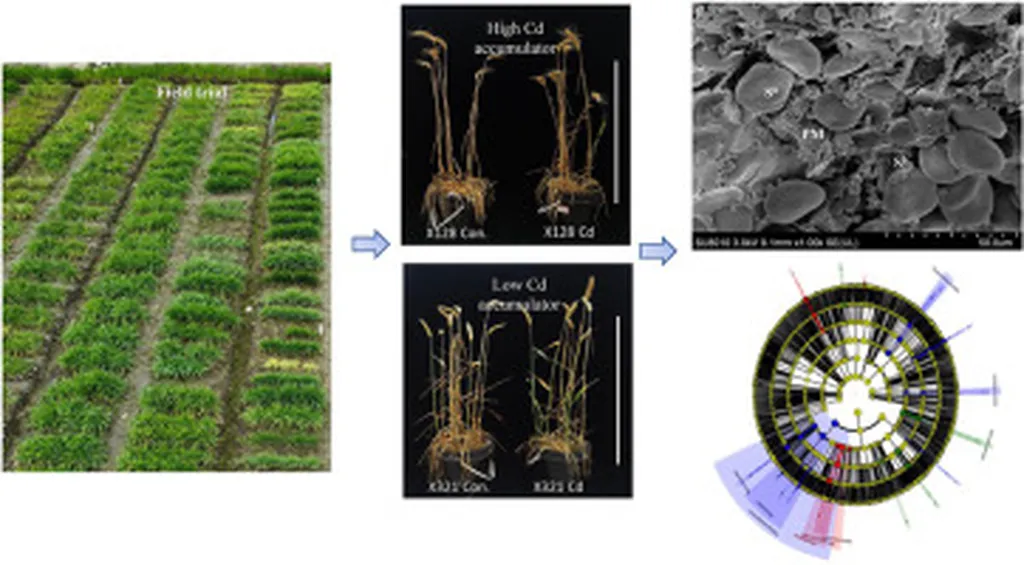In the heart of China’s Zhejiang province, researchers at Zhejiang University are unraveling the intricate dance of microorganisms in the rhizosphere—the narrow region of soil surrounding plant roots—that could hold the key to mitigating the impacts of cadmium (Cd) contamination in wheat crops. Led by Yunfeng Xu from the Institute of Crop Science, this groundbreaking study, published in the journal *Crop Design* (translated from Chinese), is shedding light on how these tiny organisms respond to heavy metal stress, with potential implications for food safety and agricultural sustainability.
Cadmium, a toxic heavy metal, is a growing concern in agriculture due to its persistence in the environment and its ability to accumulate in crops. “Cadmium contamination poses a significant threat to crop production and food safety,” Xu explains. “Understanding how rhizosphere microorganisms respond to Cd stress is crucial for developing strategies to safeguard our food supply.”
The research team investigated the impacts of Cd on soil microbial communities in the rhizosphere of wheat plants using advanced sequencing techniques. They found that even low concentrations of Cd significantly increased Cd levels in wheat grains, although it did not inhibit plant growth. This finding is particularly alarming as it highlights the potential for Cd to enter the food chain without obvious warning signs.
One of the most striking discoveries was the differential response of bacteria and fungi to Cd stress. “Bacterial abundance and diversity were significantly decreased in the soil rhizosphere when exposed to Cd, whereas little changes were observed in fungi,” Xu notes. This divergence suggests that bacteria may be more sensitive to Cd stress, which could have implications for their role in plant health and soil ecosystems.
The study identified specific bacterial and fungal operational taxonomic units (OTUs) that were unique to either normal or Cd-stressed conditions. Notably, the functions of the identified bacteria were enriched in various biological processes, including human diseases, metabolism, and environmental information processing. This suggests that these microorganisms play a complex and multifaceted role in responding to Cd stress.
Perhaps most intriguing was the revelation of a complicated bacterial co-occurrence network responding to Cd, with core bacteria belonging to the Acidobacteria, Nitrospirae, and Chloroflexi phylums. “This network highlights the intricate interactions between different bacterial species in the rhizosphere and their collective response to Cd stress,” Xu explains.
The implications of this research are far-reaching. By understanding how rhizosphere microorganisms respond to Cd stress, scientists can develop targeted strategies to mitigate the impacts of heavy metal contamination in crops. This could involve the use of beneficial microorganisms to enhance plant resilience, improve soil health, and ensure food safety.
Moreover, this study provides a foundation for future research into the role of rhizosphere microorganisms in responding to other environmental stresses, such as drought, salinity, and nutrient deficiency. As Xu puts it, “Our findings open up new avenues for exploring the potential of beneficial microorganisms in sustainable agriculture.”
In the broader context, this research underscores the importance of interdisciplinary approaches in addressing global challenges in agriculture and food security. By combining advanced sequencing technologies with ecological and agricultural sciences, researchers are gaining unprecedented insights into the complex interactions that shape our ecosystems.
As the world grapples with the impacts of climate change, pollution, and population growth, the need for sustainable and resilient agricultural practices has never been greater. This study by Yunfeng Xu and his team at Zhejiang University is a testament to the power of scientific inquiry in driving innovation and shaping the future of agriculture. With further research and application, the insights gained from this study could pave the way for a safer, more sustainable food supply for generations to come.

